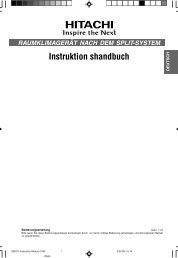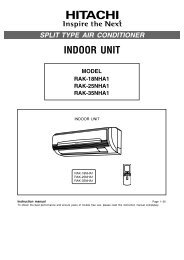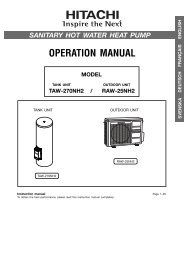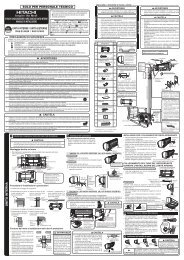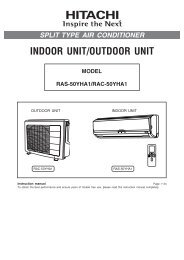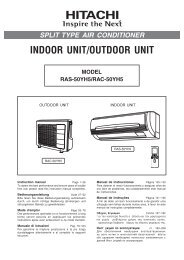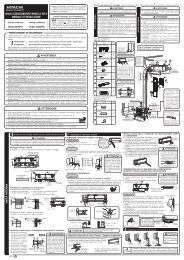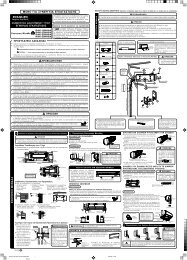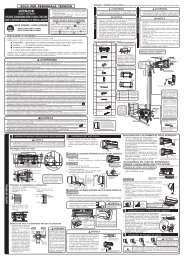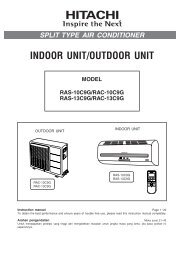( ) split unit air conditioner installation manual for service personnel ...
( ) split unit air conditioner installation manual for service personnel ...
( ) split unit air conditioner installation manual for service personnel ...
Create successful ePaper yourself
Turn your PDF publications into a flip-book with our unique Google optimized e-Paper software.
9<br />
HITACHI<br />
●<br />
●<br />
●<br />
●<br />
●<br />
●<br />
●<br />
●<br />
●<br />
●<br />
●<br />
●<br />
●<br />
●<br />
●<br />
●<br />
●<br />
SPLIT UNIT AIR CONDITIONER<br />
INSTALLATION MANUAL<br />
Indoor Unit<br />
RAS-X10CZ<br />
FOR SERVICE PERSONNEL ONLY<br />
HFC<br />
R410A<br />
SAFETY PRECAUTION<br />
Outdoor Unit<br />
RAC-X10CZ<br />
● Carefully read through the procedures of proper<br />
<strong>installation</strong> be<strong>for</strong>e starting <strong>installation</strong> work.<br />
● The sales agent should in<strong>for</strong>m customers regarding<br />
the correct operation of <strong>installation</strong>.<br />
Tools Needed For Installation Work<br />
( mark is tool exclusive use <strong>for</strong> R410A)<br />
● + – Screwdriver ● Measuring Tape ● Knife ● Saw<br />
● Pipe Cutter ● Hexagonal Wrench Key ( 4mm)<br />
● Power Drill (ø 65mm ~ ø 80mm) ● Vacuum Pump<br />
● Pliers or Wrench ● Torque Wrench Vacuum Pump<br />
Adaptor Flare Tool Gas Leakage Detector<br />
Manifold Valve Charge Hose<br />
Read the safety precautions carefully be<strong>for</strong>e operating the <strong>unit</strong>.<br />
The contents of this section are vital to ensure safety. Please pay special attention to the following sign.<br />
! WARNING ........ Incorrect methods of <strong>installation</strong> may cause death or serious injury.<br />
! CAUTION ......... Improper <strong>installation</strong> may result in serious consequence.<br />
Be sure that the <strong>unit</strong> operates in proper condition after <strong>installation</strong>. Explain to customer the proper way of operating<br />
the <strong>unit</strong> as described in the user’s guide.<br />
This <strong>air</strong> <strong>conditioner</strong> uses new refrigerant HFC (R410A).<br />
The basic <strong>installation</strong> work procedures are the same as conventional refrigerant (R22) models.<br />
However, pay careful attention to the following points:<br />
(1) Since the working pressure is 1.6 times higher than that of conventional refrigerant (R22) models, some of the piping and <strong>installation</strong> and <strong>service</strong> tools are special.<br />
Especially, when replacing a conventional refrigerant (R22) model with a new refrigerant R410A model, always replace the conventional piping and flare nuts with the<br />
R410A piping and flare nuts.<br />
(2) Models that use refrigerant R410A have a different charging port thread diameter to prevent erroneous charging with conventional refrigerant (R22) and <strong>for</strong> safety. There<strong>for</strong>e,<br />
check be<strong>for</strong>ehand. [The charging port thread diameter <strong>for</strong> R410A is 1/2 UNF 20 threads per inch.]<br />
(3) Be more careful that <strong>for</strong>eign matter (oil, water, etc.) does not enter the piping than with refrigerant (R22) models. Also, when storing the piping, securely seal the<br />
openings by pinching, taping, etc.<br />
(4) When charging the refrigerant, take into account the slight change in the composition of the gas and liquid phases, and always charge from the liquid phase side whose<br />
composition is stable.<br />
!<br />
WARNING<br />
Please request your sales agent or qualified technician to install your <strong>unit</strong>. Water leakage, short circuit or fire may occur if you do the <strong>installation</strong> work yourself.<br />
Please observe the instructions stated in the <strong>installation</strong> <strong>manual</strong> during the process of <strong>installation</strong>. Improper <strong>installation</strong> may cause water leakage, electric shock and<br />
fire.<br />
Make sure that the <strong>unit</strong>s are mounted at locations which are able to provide full support to the weight of the <strong>unit</strong>s. If not, the <strong>unit</strong>s may collapse and impose danger.<br />
Observe the rules and regulations of the electrical <strong>installation</strong> and the methods described in the <strong>installation</strong> <strong>manual</strong> when dealing with the electrical work. Use power<br />
cables approved by the authorities of your country.<br />
Be sure to use the specified wire <strong>for</strong> connecting the indoor and outdoor <strong>unit</strong>s. Please ensure that the connections are tight after the conductors of the wire are inserted<br />
into the terminals. Improper insertion and loose contact may cause over-heating and fire.<br />
Please use the specified components <strong>for</strong> <strong>installation</strong> work. Otherwise, the <strong>unit</strong>s may collapse or water leakage, electric shock and fire may occur.<br />
Be sure to use the specified piping set <strong>for</strong> R-410A. Otherwise, this may result in broken copper pipes or faults.<br />
When installing or removing an <strong>air</strong> <strong>conditioner</strong>, only specified refrigerant (R410A) shall be allowed, do not allow <strong>air</strong> or moisture to remain in the refrigeration cycle.<br />
Otherwise, pressure in the refrigeration cycle may become abnormally high so that a rupture may be caused.<br />
Be sure to ventilate fully if a refrigerant gas leak while at work. If the refrigerant gas comes into contact with fire, a poisonous gas may occur.<br />
After completion of <strong>installation</strong> work, check to make sure that there is no refrigeration gas leakage. If the refrigerant gas leaks into the room, coming into contact with<br />
fire in the fan-driven heater, space heater, etc., a poisonous gas may occur.<br />
Unauthorized modifications to the <strong>air</strong> <strong>conditioner</strong> may be dangerous. If a breakdown occurs please call a qualified <strong>air</strong> <strong>conditioner</strong> technician or electrician. Improper<br />
rep<strong>air</strong>s may result in water leakage, electric shock and fire, etc.<br />
! CAUTION<br />
A circuit breaker or fuse (16A time delay) must be installed. Without a circuit breaker or fuse the danger of electric shock exists.<br />
A main switch with a contact gap of more than 3mm has to be installed in the power supply line to the outdoor <strong>unit</strong>.<br />
Do not install the <strong>unit</strong> near a location where there is flammable gas. The outdoor <strong>unit</strong> may catch fire if flammable gas leaks around it.<br />
Please ensure smooth flow of water when installing the drain hose.<br />
Piping shall be suitable supported with a maximum spacing of 1m between the supports.<br />
THE CHOICE OF MOUNTING SITE (Please note the following matters and obtain permission from customer be<strong>for</strong>e <strong>installation</strong>).<br />
! WARNING<br />
! WARNING<br />
INDOOR UNIT<br />
● The <strong>unit</strong> should be mounted at stable, non-vibratory location which<br />
can provide full support to the <strong>unit</strong>.<br />
!<br />
CAUTION<br />
● No nearby heat source and no obstruction near the <strong>air</strong> outlet is<br />
allowed.<br />
● The clearance distances from top, right and left are specified in<br />
figure below.<br />
● The location must be convenient <strong>for</strong> water drainage and pipe<br />
connection with the Outdoor <strong>unit</strong>.<br />
● To avoid interference from noise please place the <strong>unit</strong> and its<br />
remote controller at least 1m from the radio, television and inverter<br />
type fluorescent lamp.<br />
● To avoid any error in signal transmission from the remote controller,<br />
please put the controller far away from high-frequency machines<br />
and high-power wireless systems.<br />
● The <strong>installation</strong> height of indoor <strong>unit</strong> must be 2.3m or more.<br />
Names of Indoor Components<br />
No.<br />
Hanger<br />
Item<br />
Qty<br />
1 1<br />
Screw <strong>for</strong> Hanger<br />
2<br />
(4.1x32)<br />
6<br />
Holder <strong>for</strong> Remote<br />
Controller<br />
3 1<br />
AAA Size Battery<br />
4 2<br />
Screw <strong>for</strong> holder of<br />
5<br />
Remote Controller<br />
(3.1x16)<br />
2<br />
6<br />
7<br />
Remote Controller<br />
Purifying Filter<br />
Hole cover sticker<br />
8 1<br />
1<br />
1<br />
Direction of Piping<br />
Connection<br />
Horizontally<br />
perpendicular<br />
to the <strong>unit</strong><br />
There are 4 directions<br />
allowed, namely, horizontally<br />
perpendicular to the <strong>unit</strong>,<br />
vertically down from right,<br />
horizontally out from right and<br />
horizontally out to left.<br />
Don’t <strong>for</strong>m the piping<br />
downward at the left of the <strong>unit</strong>.<br />
Dimension of Mounting Stand<br />
of the Outdoor <strong>unit</strong><br />
(<strong>unit</strong> : mm)<br />
45<br />
mounting stand<br />
30<br />
16<br />
12<br />
30<br />
500 102<br />
20<br />
above 100mm<br />
282 9<br />
300<br />
above 700mm<br />
OUTDOOR UNIT<br />
about 300mm<br />
above 200mm<br />
above 50mm when<br />
installed on the<br />
( )<br />
ceiling of balcony<br />
● The Outdoor <strong>unit</strong> must be mounted at a location which can support<br />
heavy weight. Otherwise, noise and vibration will increase.<br />
! CAUTION<br />
● Do not expose the <strong>unit</strong> under direct sunshine or rain. Besides,<br />
ventilation must be good and clear of obstruction.<br />
● The <strong>air</strong> blown out of the <strong>unit</strong> should not point directly to animals<br />
or plants.<br />
● The clearances of the <strong>unit</strong> from top, left, right and front are specified<br />
in figure below. At least 3 of the above sides must be open <strong>air</strong>.<br />
● Be sure that the hot <strong>air</strong> blown out of the <strong>unit</strong> and noise do not<br />
disturb the neighbourhood.<br />
● Do not install at a location where there is flammable gas, steam,<br />
oil and smoke.<br />
● The location must be convenient <strong>for</strong> water drainage.<br />
● Place the Outdoor <strong>unit</strong> and its connecting cord at least 1m away<br />
from the antenna or signal line of television, radio or telephone.<br />
This is to avoid noise interference.<br />
● Do not install outdoor <strong>unit</strong> facing strong wind direction. It may<br />
damage the fan motor.<br />
Figure showing the Installation<br />
of Indoor and Outdoor Unit.<br />
Be sure to<br />
completely<br />
seal any<br />
gap with<br />
putty.<br />
about 400mm<br />
must not bend<br />
! CAUTION<br />
In case the pipe length is more than<br />
8m, add refrigerant R410A at 15 gram<br />
per every meter exceeds. However,<br />
pipe length shall not exceed 20m.<br />
Maximum pipe length 20m<br />
Minimum pipe length 4m<br />
above 100mm<br />
Plug<br />
above 50mm<br />
3<br />
5<br />
above 100mm<br />
give clearance as<br />
wide as possible<br />
above 200mm<br />
1<br />
2,300mm or more<br />
4<br />
! CAUTION<br />
• The <strong>installation</strong> height<br />
of indoor <strong>unit</strong> must be<br />
2.3m or more.<br />
6<br />
2<br />
above 100mm<br />
The indoor piping should be<br />
insulated with the enclosed<br />
insulation pipe. (If the<br />
insulator is insufficient,<br />
please use commersial<br />
products).<br />
● The difference in height<br />
between the indoor and<br />
outdoor <strong>unit</strong> should be<br />
kept max 10m.<br />
● The connecting pipe, no<br />
matter big or small,<br />
should all be insulated<br />
with insulation pipe and<br />
then wrapped with vinyl<br />
tape. (The insulator will<br />
deteriorate if it is not<br />
wrapped with tape).<br />
The connection of insulated<br />
drain hose.<br />
inner diameter ø 16mm<br />
Please use insulated drain<br />
hose <strong>for</strong> the indoor piping<br />
(commercial product).<br />
INDOOR UNIT<br />
1<br />
Installation of Hanger, Wall Penetration and Installation of Protection Pipe<br />
!<br />
CAUTION<br />
● The draining of the water container inside the indoor <strong>unit</strong> can be done from the left.<br />
There<strong>for</strong>e the hanger must be fixed horizontally or slightly tilted towards the side of<br />
drain hose. Otherwise, condensed water may overflow the water container.<br />
Direct Mounting On The Wall<br />
● Please use hidden beams in the wall to hold the hanger.<br />
Procedures of Installation and Precautions<br />
● Procedures to fix the hanger.<br />
1.Drill holes on wall. 2. Push plug into the holes. 3. Fix the hanger on wall<br />
(As shown below) (As shown below) with 4.1 x 32 screw<br />
(As shown in figure below)<br />
ø4.8mm<br />
Wall<br />
● Procedures to fix the holder of remote control.<br />
1.Drill holes on wall. 2. Push plug into the holes.<br />
(As shown below) (As shown below)<br />
Wall<br />
ø4.4mm<br />
45mm<br />
60mm<br />
Wall Penetration and Installation of Protection Pipe<br />
● Drill a ø 65mm hole on<br />
wall which is slightly tilted<br />
towards the outdoor side.<br />
Drill the wall at a small<br />
angle.<br />
● Cut the protection pipe<br />
according to the wall<br />
thickness.<br />
● Empty gap in the sleeve<br />
of protection pipe should<br />
be completely sealed<br />
with putty to avoid<br />
dripping of rain water into<br />
the room.<br />
<br />
32mm<br />
20mm<br />
125mm<br />
1 Hanger<br />
2 Screw<br />
3<br />
200mm<br />
Wall<br />
Remote<br />
Control<br />
Holder<br />
Indoor<br />
Seal with<br />
putty<br />
Protection<br />
pipe<br />
80mm<br />
Screw <strong>for</strong> Hanger<br />
Please use more<br />
than 4 screws.<br />
780mm<br />
WALL<br />
Mark<br />
Plug<br />
Plug<br />
5 Screw<br />
Outdoor<br />
2 ~ 5mm<br />
Seal with<br />
putty<br />
Sleeve of<br />
protection<br />
pipe<br />
280mm<br />
above 50mm<br />
125mm<br />
45mm<br />
115mm<br />
450mm<br />
Line<br />
Weight<br />
4.1 x 32 Screw<br />
Level<br />
Ceiling<br />
! WARNING<br />
Hanger<br />
Hole <strong>for</strong> pipe<br />
Be sure that the wire is not<br />
in contact with any metal<br />
in the wall. Please use the<br />
protection pipe as wire<br />
passing through the hollow<br />
part of the wall so as to<br />
prevent the possibility of<br />
damaged by mouse.<br />
Unless it seals completely,<br />
any <strong>air</strong> with high humidity<br />
flows from outdoor and<br />
any dew may drop.<br />
2 Installation of the Indoor Unit<br />
VERTICALLY DOWNWARD PIPING<br />
Preparation<br />
● Connect connecting cord.<br />
● Pull out the pipe, connecting cord and drain hose.<br />
Connecting cords, pipe and<br />
Installation<br />
drain hose must be laid<br />
together with Vinyl tape.<br />
● The upper part of the Indoor <strong>unit</strong> is hanged on the hanger.<br />
● The projection at the lower part of the Indoor <strong>unit</strong> is hooked onto the hanger.<br />
Hanger<br />
HORIZONTAL PIPING<br />
Preparation<br />
Refrigerating<br />
Pipe<br />
Protection<br />
Pipe Drain Hose Connecting<br />
Cord<br />
Lift the body<br />
of the <strong>unit</strong><br />
upwards and<br />
then <strong>for</strong>ce it<br />
downwards.<br />
Hanger<br />
Change of Drain Hose and Installation Procedures.<br />
! CAUTION<br />
Please pull the lower part of<br />
the Indoor <strong>unit</strong> outwards to<br />
check if the <strong>unit</strong> is hooked<br />
onto the hanger. Improper<br />
<strong>installation</strong> may cause<br />
vibration and noise.<br />
● Exchange the location of drain hose and drain cap during horizontal piping as shown in<br />
figure below. Be sure to plug in the drain hose until the insulating material folds upon itself.<br />
● Please use pliers to pull out the drain cap.<br />
(This is an easier way to remove the drain cap).<br />
Drain cap<br />
Please insert<br />
until here<br />
Drain cap<br />
2<br />
1<br />
Projection<br />
Drain hose<br />
[Push] mark positions<br />
! CAUTION Condensed water may leak out if not inserted properly.<br />
HORIZONTAL & DOWNWARD PIPING – MAKING OPENINGS<br />
● During horizontal or downward piping, use a knife to cut<br />
openings as shown in figure. Then smoothen the edges of<br />
openings with a file.<br />
Pipe<br />
support<br />
HOW TO REMOVE INDOOR UNIT<br />
● Push up the (PUSH) sections at the<br />
bottom of the indoor <strong>unit</strong> and pull the<br />
bottom plate towards you. Then the<br />
claws are released from the stationary<br />
plate.<br />
(The (PUSH) sections are indicated by<br />
2 arrows in the right figure)<br />
Pull up the pipe after<br />
bending downward<br />
Drain hose<br />
Please insert<br />
until here<br />
Openings<br />
● Turn the piping while holding down the lower<br />
portion of pipe-support by hand.<br />
INSTALLATION OF REFRIGERATING PIPES AFTER CONNECTION<br />
● The refrigerating pipes should be adjusted to fit into<br />
the hole on the wall and then ready <strong>for</strong> further<br />
connection.<br />
● The terminals of 2 connected pipes must be covered<br />
with insulator used <strong>for</strong> terminal connection. Then the<br />
pipes are wrapped with insulation pipe.<br />
● Connect the connecting cord after removing electrical<br />
cover. (Refer to “CONNECTION OF POWER CORD”)<br />
● After adjustment, fit the connecting cord and pipes<br />
into the space available under the indoor <strong>unit</strong>. Use<br />
holder to hold them tight.<br />
●<br />
Holder can be attached at the either of 2 places.<br />
Please select the easier position.<br />
! CAUTION<br />
● The rubber strap used <strong>for</strong><br />
fixing the insulator should<br />
not be tied with great <strong>for</strong>ce.<br />
Otherwise, this will damage<br />
heat insulation and causes<br />
water condensation.<br />
THE CONNECTION OF REFRIGERATING PIPE DURING THE<br />
INSTALLATION OF INDOOR UNIT<br />
Preparation To Install Refrigerating Pipes ! CAUTION<br />
● The refrigerating pipes and connecting cord<br />
trans<strong>for</strong>m and are attached.<br />
● The end of the refrigerating pipes are at locations<br />
marked with “ ” symbol.<br />
3<br />
Installation<br />
Hang the Indoor <strong>unit</strong> onto the hanger. Use the temporary stand<br />
at the back of the Indoor <strong>unit</strong> to push its lower part 15cm<br />
<strong>for</strong>wards.<br />
● Place the drain hose through the hole on the wall.<br />
● Wrap the refrigerating pipes with insulation pipe after<br />
connecting refrigerating pipe.<br />
● Connect the connecting cord after removing electrical cover.<br />
(Refer to “Connection of Power Cord”)<br />
● After adjustment, the connecting cord and refrigerating pipes<br />
are placed into the space available under the Indoor <strong>unit</strong>.<br />
● The projection of Indoor <strong>unit</strong> must hook to the hanger.<br />
!<br />
CAUTION<br />
Insulation pipe (must be wrapped with<br />
vinyl tape at every 120mm).<br />
Heat insulation pipe<br />
Refrigerating pipe<br />
0.85m<br />
Connecting<br />
cord<br />
Pull this to the front<br />
during the connection<br />
of refrigerating pipes<br />
to ease task.<br />
Installation of Drain Hose<br />
Bending<br />
upwards<br />
Condensed<br />
water pond<br />
Ditch<br />
● Please fix in the plastic core<br />
after flaring to avoid plastic<br />
chips entering the pipes.<br />
! CAUTION<br />
Be sure that the<br />
drain hose is not<br />
loosely connected<br />
or bend.<br />
You are free to choose the side (left or right) <strong>for</strong> the <strong>installation</strong> of drain<br />
hose. Please ensure the smooth flow of condensed water of the Indoor<br />
<strong>unit</strong> during <strong>installation</strong>. (Carelessness may result in water leakage.)<br />
Pipe<br />
Please bend at a small<br />
radius to <strong>for</strong>m an arc<br />
Protection pipe<br />
Condensed<br />
water pond<br />
Drain hose<br />
Connecting cord<br />
Pipe<br />
Drain hose<br />
Connecting<br />
cord<br />
Rubber strap tied with great <strong>for</strong>ce<br />
Projection<br />
Holder<br />
below<br />
5mm<br />
about 15cm<br />
Hook<br />
Connected<br />
section<br />
(EN1) INS RAS-X10CZ 1<br />
18/12/09, 9:29
OUTDOOR UNIT<br />
● Please mount the outdoor <strong>unit</strong> on stable ground to prevent vibration<br />
and increase of noise level.<br />
● Decide the location <strong>for</strong> piping after sorting out the different types of<br />
pipe available.<br />
● Open the side plate by unscrewing the screws as shown below.<br />
Please face this side<br />
(suction side) of the <strong>unit</strong> to<br />
the wall.<br />
Please remove side cover<br />
when connecting the<br />
connecting cord.<br />
INSTALLATION OF REFRIGERATING PIPES AND AIR REMOVAL<br />
1<br />
Preparation of Pipe<br />
● Use a pipe cutter to cut the copper pipe.<br />
● Jagged edge will cause leakage.<br />
● Point the side to be trimmed downwards during trimming to prevent copper<br />
chips from entering the pipe.<br />
● Be<strong>for</strong>e flaring, please put on the flare nut.<br />
2<br />
!<br />
Wrench<br />
Die<br />
Outer<br />
Diameter (mm)<br />
6.35 (1/4)<br />
9.52 (3/8)<br />
12.70 (1/2)<br />
15.88 (5/8)<br />
Pipe Connection<br />
CAUTION<br />
!<br />
Copper pipe<br />
CAUTION<br />
Die<br />
A<br />
Copper pipe<br />
Trimming tool<br />
● Recommend to use<br />
R410A flaring tool.<br />
A (mm)<br />
Flare tool <strong>for</strong> R410A Conventional flare tool<br />
Clutch type Clutch type Wing nut type<br />
0.0 ~ 0.5<br />
0.0 ~ 0.5<br />
0.0 ~ 0.5<br />
0.0 ~ 0.5<br />
1.0~1.5<br />
1.0~1.5<br />
1.0~1.5<br />
1.0~1.5<br />
1.5~2.0<br />
1.5~2.0<br />
1.5~2.5<br />
1.5~2.5<br />
In case of removing flare nut of an Indoor <strong>unit</strong>, first remove a nut<br />
of small diameter side, or a seal cap of big diameter side will fly<br />
out. Prevent water from entering into the piping when working.<br />
Flare nut<br />
Thickness<br />
(mm)<br />
Torque<br />
wrench<br />
0.8<br />
0.8<br />
0.8<br />
1.0<br />
Small dia. side<br />
Large dia. side<br />
Valve<br />
head cap<br />
Valve core cap<br />
Small dia. side<br />
Large dia. side<br />
Outer<br />
dia.of pipe<br />
6.35 (1/4")<br />
9.52 (3/8")<br />
12.7 (1/2")<br />
6.35 (1/4")<br />
9.52 (3/8")<br />
12.7 (1/2")<br />
Torque N·m<br />
(kgf · cm)<br />
13.7 – 18.6 (140 – 190)<br />
34.3 – 44.1 (350 – 450)<br />
44.1 – 53.9 (450 – 550)<br />
19.6 – 24.5 (200 ~ 250)<br />
19.6 – 24.5 (200 ~ 250)<br />
29.4 – 34.3 (300 – 350)<br />
12.3 – 15.7 (125 ~ 160)<br />
3<br />
AIR REMOVAL<br />
Removal Of Air From The Pipe And Gas Leakage Inspection<br />
1<br />
2<br />
3<br />
4<br />
Procedures of using Vacuum Pump <strong>for</strong> Air Removal<br />
As shown in right figure, remove the cap<br />
of valve core. Then, connect the charge<br />
hose. Remove the cap of valve head.<br />
Connect the vacuum pump adapter to<br />
the vacuum pump and connect the<br />
charge hose to the adapter.<br />
Fully tighten the “Hi” shuttle of the<br />
manifold valve and completely unscrew<br />
the “Lo” shuttle. Run the vacuum pump<br />
<strong>for</strong> about 10–15 minutes, then completely<br />
tighten the “Lo” shuttle and switch off<br />
the vacuum pump.<br />
Completely unscrew the spindle of the<br />
<strong>service</strong> valve (at 2 places) in anticlockwise<br />
direction to allow the flow of<br />
refrigerant (using Hexagonal Wrench<br />
key).<br />
Remove the charge hose and tighten the<br />
cap of valve head. Check the cap’s<br />
periphery if there is any gas leakage.<br />
The task is then completed.<br />
Gas Leakage Inspection<br />
Please use gas leakage detector to check if leakage<br />
occurs at the connection of Flare nut as shown on<br />
the right.<br />
If gas leakage occurs, further tighten the connection<br />
to stop leakage. (Use the detector provided <strong>for</strong><br />
R410A)<br />
When the meter reaches - 101KPa<br />
(-76cmHg) during pumping, fully<br />
tighten the shuttle.<br />
Meter showing pressure<br />
Closed<br />
Charge hose<br />
Valve<br />
Lo<br />
Valve<br />
Vacuum pump<br />
adapter<br />
R410A<br />
Manifold valve<br />
Vacuum<br />
pump<br />
When pumping starts, slightly loosen the<br />
flare nut to check of <strong>air</strong> sucked in. Then<br />
tighten the flare nut.<br />
Cap of valve head<br />
Hi<br />
The body of<br />
<strong>service</strong> valve<br />
Cap of<br />
valve core<br />
Hexagonal<br />
Wrench Key<br />
Cap of valve head<br />
!<br />
WARNING<br />
Procedures of Wiring<br />
● THIS APPLIANCE MUST<br />
BE EARTHED.<br />
Power supply shall be connected at the rated voltage, otherwise<br />
the <strong>unit</strong> will be broken or could not reach the specified capacity.<br />
Wiring Of The Indoor Unit<br />
● For wire connection of the Indoor <strong>unit</strong>, you need to remove Low Cover and Indicator Cover.<br />
1<br />
2<br />
3<br />
● Pull the cover at 1 and 2 in<br />
the directions as shown by<br />
arrows to remove the low<br />
cover.<br />
Indoor Unit<br />
Outdoor Unit<br />
TEMPORARY<br />
SWITCH<br />
TEMPORARY<br />
SWITCH<br />
C D<br />
1.6 or<br />
2.0<br />
L N C D<br />
Indicator<br />
Cover<br />
Screw<br />
Low cover<br />
CONNECTION OF POWER CORD<br />
Outdoor Unit<br />
Connecting Cord<br />
Strip wires<br />
25mm 25mm<br />
10mm<br />
10mm<br />
GRN + 10mm<br />
YEL 35mm<br />
Power line<br />
Control line<br />
Detail of cutting the connecting cord<br />
Connecting Cord<br />
2.0<br />
AC 220 - 240V<br />
Indoor Unit<br />
30mm<br />
10mm<br />
10mm<br />
70mm<br />
GRN + YEL<br />
Strip wires<br />
When removing the connecting wires <strong>for</strong> the Indoor <strong>unit</strong>,<br />
please remove the low cover panel in front of the <strong>unit</strong>.<br />
!<br />
WARNING<br />
● The naked part of the wire core should be 10 mm and<br />
fix it to the terminal tightly. Then try to pull the individual<br />
wire to check if the contact is tight. Improper insertion<br />
may burn the terminal.<br />
● Be sure to use only power cables approved from the<br />
authorities in your country. For example in Germany:<br />
Cable type: NYM 3x1.5mm 2 (Fuse = 16A time delay).<br />
● Please refer to the <strong>installation</strong> <strong>manual</strong> <strong>for</strong> wire connection<br />
to the terminals of the <strong>unit</strong>s. The cabling must meet the<br />
standards of electrical <strong>installation</strong>.<br />
● There is a AC voltage of 220-240V between the L and<br />
N terminals. There<strong>for</strong>e, be<strong>for</strong>e servicing, be sure to<br />
remove the plug from the AC outlet or switch off the<br />
main switch.<br />
● Do not make any connection in the middle of the<br />
connecting cable. It may cause the wire over heated,<br />
emit smoke and fire.<br />
TEMPORARY<br />
SWITCH<br />
Attach Indicator Cover and tightened screw<br />
(do not tightened too hard as the screw hole<br />
at front cover might be broken)<br />
7<br />
TEMPORARY<br />
SWITCH<br />
5<br />
Remove Screw and Indicator Cover<br />
Attach back Low Cover<br />
Wiring of The Outdoor Unit<br />
● Please remove the side plate <strong>for</strong> wire connection.<br />
!<br />
WARNING<br />
● If you cannot attach the side<br />
plate due to the connecting<br />
cord, please press the<br />
connecting cord in direction<br />
to the front panel to fix it.<br />
● Be sure that the hooks of the<br />
side plate is fixed in certainly.<br />
Otherwise water leakage may<br />
occur and this causes short<br />
circuit or faults.<br />
4<br />
!<br />
WARNING<br />
● Investigate the power supply capacity and other<br />
electrical conditions at the <strong>installation</strong> location.<br />
Depending on the model of room <strong>air</strong> <strong>conditioner</strong><br />
to be installed, request the customer to make<br />
arrangements <strong>for</strong> the necessary electrical work<br />
etc.<br />
The electrical work includes the wiring work up<br />
the outlet. In localities where electrical<br />
conditions are poor, use of a voltage regulation<br />
is recommended.<br />
● Install outlet <strong>for</strong> the room <strong>air</strong> <strong>conditioner</strong> within<br />
the reaching range of the line cord.<br />
IMPORTANT<br />
D<br />
C<br />
● Please fix back the electrical<br />
plate after wiring work is<br />
complete. Otherwise if short<br />
circuit occur it may cause<br />
<strong>unit</strong> burn.<br />
Fuse Capacity<br />
16A time delay fuse<br />
After remove the screw and cover,<br />
and put the connecting cords and fix<br />
the cover with screw.<br />
Connect the<br />
earth cord<br />
Earth terminal<br />
LNC D<br />
FINAL STAGE OF INSTALLATION<br />
1<br />
Insulation And Maintenance Of Pipe Connection<br />
● The connected terminals should be completely sealed with<br />
heat insulator and then tied up with rubber strap.<br />
● Please tie the pipe and power line together with vinyl tape as<br />
shown in the figure showing the <strong>installation</strong> of Indoor and<br />
Outdoor <strong>unit</strong>s. Then fix their position with holders.<br />
● To enchance the heat insulation and to prevent water<br />
condensation, please cover the outdoor part of the drain hose<br />
and pipe with insulation pipe.<br />
● Completely seal any gap with putty.<br />
Insulation material <strong>for</strong> pipe connection<br />
3<br />
Sleeve of<br />
protection pipe<br />
Power Source And Operation Test<br />
Power Source<br />
Putty<br />
!<br />
CAUTION<br />
Putty<br />
2<br />
Installation Of Remote Controller<br />
● The remote controller can be placed in its holder which is<br />
fixed on wall or beam.<br />
● To operate the remote controller at its holder, please ensure<br />
that the <strong>unit</strong> can receive signal transmitted from the controller<br />
at the place where the holder is to be fixed. The <strong>unit</strong> will beep<br />
when signal is received from the remote controller. The signal<br />
transmission is weaken by the fluorescent light. There<strong>for</strong>e,<br />
during the <strong>installation</strong> of the remote control holder, please<br />
switch on the light, even during day time, to determine the<br />
mounting location of the holder.<br />
The controller should be<br />
insert from top into<br />
bottom side of the holder<br />
as shown in figure below.<br />
Remote<br />
Controller<br />
Screw (2 pieces)<br />
Holder <strong>for</strong><br />
Remote Controller<br />
Pump Down Method When Reuse<br />
Existing Piping (R22 Model) <strong>for</strong><br />
R410A Model<br />
● Compressor oil of R22 model is insoluble in compressor<br />
oil of R410A model. The mixing of compressor oil may<br />
cause damage of compressor.<br />
Possibility of Mixing<br />
● Reuse of piping of R22 model is dangerous because of its<br />
compressor oil.<br />
● When reuse piping of R22 model, pump down must be<br />
carried out properly to ensure compressor oil which is<br />
remained inside piping is collected away.<br />
!<br />
CAUTION<br />
Reuse of piping R-22 model only apply if previous model<br />
is Hitachi and proper pump down method is used.<br />
To Reuse Old Piping<br />
● Piping of R22 model can be reused only when <strong>air</strong><strong>conditioner</strong><br />
is properly pumped down.<br />
● The purpose of pump down is to collect back the<br />
compressor oil (which is mixed with refrigerant and<br />
circulating inside refrigeration cycle) properly into the<br />
outdoor <strong>unit</strong> of <strong>air</strong> <strong>conditioner</strong>.<br />
Proper Pump Down Method<br />
1 Operate <strong>air</strong> <strong>conditioner</strong> 2 After 10~15 minutes of pre<br />
at cooling mode <strong>for</strong><br />
operation, close 2s valve.<br />
10~15 minutes. After 3 minutes, close 4s valve.<br />
Most Important Process<br />
Purpose: To make the oil &<br />
refrigerant mix together.<br />
They are in separated<br />
condition when<br />
<strong>air</strong> <strong>conditioner</strong> is<br />
stopped.<br />
Mixed<br />
refrigerant & oil<br />
will be collected<br />
into outdoor<br />
<strong>unit</strong>.<br />
3 Take out <strong>air</strong> <strong>conditioner</strong> 4 Install New Refrigerant <strong>air</strong><br />
<strong>unit</strong>.<br />
<strong>conditioner</strong><br />
It is advisable to flush the<br />
piping with R410A to avoid<br />
any contamination remain<br />
be<strong>for</strong>e new <strong>installation</strong>.<br />
● Please use a new socket. Accident may occur due to the use<br />
of old socket because of poor contact.<br />
● Please plug in and then remove the plug <strong>for</strong> 2 – 3 times. This<br />
is to ensure that the plug is completely plugged into the socket.<br />
● Keep additional length <strong>for</strong> the power cord and do not render<br />
the plug under external <strong>for</strong>ce as this may cause poor contact.<br />
● Do not fix the power cord with U-shape nail.<br />
Operation Test<br />
● Please ensure that the <strong>air</strong> <strong>conditioner</strong> is in normal operating<br />
condition during the operation test.<br />
● Explain to your customer the proper operation procedures<br />
as described in the user’s <strong>manual</strong>.<br />
<br />
(EN2) INS RAS-X10CZ 1<br />
18/12/09, 9:30
9<br />
HITACHI<br />
●<br />
●<br />
●<br />
●<br />
●<br />
●<br />
●<br />
●<br />
●<br />
●<br />
●<br />
●<br />
●<br />
●<br />
●<br />
●<br />
●<br />
●<br />
UNTUK KEGUNAAN JURUTEKNIK SAHAJA<br />
RISALAH PANDUAN PEMASANGAN<br />
PENGHAWA DINGIN BILIK<br />
Unit dalam bilik<br />
RAS-X10CZ<br />
HFC<br />
R410A<br />
Unit luar bilik<br />
RAC-X10CZ<br />
● Sila baca dengan teliti cara-cara pemasangan sebelum<br />
melakukan kerja-kerja pemasangan.<br />
● Wakil jualan harus memberi keterangan mengenai cara<br />
pengendalian kepada pelanggan mengikut arahan<br />
pengendalian.<br />
Alat-alat diperlukan untuk kerja pemasangan<br />
( adalah simbol bagi alat yang khusus untuk R410A.)<br />
● + – Pemutar skru ● Pita pengukur ● Pisau ● Gergaji<br />
● Pemotong paip ● Kunci Alen ( 4mm) ● Gerudi elektrik<br />
(ø 65mm ~ ø 80mm) ● Pam vakum ● Playar atau spana<br />
● Sepana kilas Adaptor Pam Vakum Flare tool Pengesan<br />
Kebocoran Gas Injap Pancarongga Hos Pengecas<br />
PERKARA YANG PERLU DIAMBIL PERHATIAN UNTUK KESELAMATAN<br />
Sebelum menggunakan mesin, sila telitikan “perkara-perkara yang perlu diambil perhatian untuk keselamatan” bagi mengendalikan mesin dengan betul.<br />
Perkara-perkara yang dicatatkan di bahagian ini mengandungi isi-isi penting berkenaan dengan keselamatan, oleh itu mesti mengambil perhatian terhadap perkara di<br />
bahagian ini.<br />
! AMARAN ........ Pemasangan yang salah mungkin boleh mengakibatkan kematian atau kecederaan yang serius<br />
! PERHATIAN .... Pemasangan yang salah boleh mendatangkan akibat yang teruk.<br />
Setelah kerja-kerja pemasangan siap, pastikan penyaman udara beroperasi dengan baik. Terangkan secara teliti kepada pelanggan mengenai cara pengendalian<br />
mengikut arahan pengendalian.<br />
Penghawa dingin ini menggunakan bahan penyejuk HFC (R410A)<br />
Asas prosedur-prosedur kerja pemasangan adalah sama seperti model-model bahan penyejuk (R22) yang konvensional. Walaubagaimana pun, perkara-perkara yang berikut perlu<br />
diambil perhatian:<br />
(1) Memandangkan tekanan kerja adalah 1.6 kali lebih tinggi daripada model-model bahan penyejuk (R22) yang konvensional, terdapat sesetengah paip serta peralatan pemasangan<br />
dan servis yang khas.<br />
Khususnya apabila menukar model bahan penyejuk (R22) yang konvensional dengan model bahan penyejuk R410A yang baru, paip konventional dan nat kembang (flare nut)<br />
hendaklah diganti dengan paip dan nat kembang (flare nut) R410A.<br />
(2) Model-model yang menggunakan bahan penyejuk R410A mempunyai diameter ulir liang pengecasan yang berbeza bagi mengelakkan kerosakan serta untuk keselamatan<br />
semasa mengecas dengan bahan penyejuk (R22) yang konventional. Oleh itu, pastikan dahulu. (Diameter ulir liang pengecasan bagi R410A adalah 1/2 UNF 20 ulir setiap inci.)<br />
(3) Hati-hati agar benda-benda asing (minyak, <strong>air</strong> dan lain-lain) tidak masuk ke dalam paip bagi model bahan penyejuk (R22). Semasa menyimpan paip, tutup bukaan paip.<br />
(4) Semasa mengecas bahan penyejuk, perhatikan perubahan komposisi gas dan fasa cec<strong>air</strong>. Cas daripada bahagian fasa cec<strong>air</strong> yang komposisinya stabil.<br />
!<br />
!<br />
AMARAN<br />
Minta wakil jualan atau juruteknik untuk melakukan kerja pemasangan. Kerja pemasangan yang dilakukan sendiri mungkin akan menyebabkan kebocoran <strong>air</strong>, kejutan elektrik dan kebakaran.<br />
Sila lakukan kerja pemasangan mengikut risalah panduan pemasangan.<br />
Pemasangan yang tidak sempurna mungkin akan menyebabkan kebocoran <strong>air</strong>, kejutan elektrik dan kebakaran.<br />
Semasa pemasangan, pastikan <strong>unit</strong>-<strong>unit</strong> dipasang pada tempat yang dapat menampung beratnya. Kalau tidak, <strong>unit</strong>-<strong>unit</strong> mungkin akan jatuh ke bawah.<br />
Patuhi peraturan-peraturan mengenai pemasangan elektrik dan kaedah-kaedah yang dihuraikan dalam <strong>manual</strong> pemasangan apabila melakukan kerja-kerja elektrik. Gunakan kabel kuasa<br />
yang diluluskan oleh pihak berkuasa negara anda.<br />
Penyambungan antara <strong>unit</strong> luar bilik dan <strong>unit</strong> dalam bilik mesti menggunakan kabel penyambung yang ditetapkan. Setelah dawai dicacahkan ke dalam terminal, pastikan cacahan itu adalah<br />
kukuh.<br />
Pemasangan yang tidak kukuh dan tidak sempurna boleh membawa kesan pemanasan dan kebakaran.<br />
Alat-alat yang diperlukan untuk kerja pemasangan mesti adalah alat-alat yang ditetapkan.<br />
Jika tidak, mungkin akan mengakibatkan <strong>unit</strong> terhempas, kebocoran <strong>air</strong>, kejutan elektrik dan kebakaran.<br />
Pastikan anda mengguna set pempaipan yang telah ditetapkan untuk R410. Kalau tidak, ini mungkin akan menyebabkan kepecahan paip tembaga atau keretakan.<br />
Semasa memasang atau menanggalkan penyaman udara, hanya bahan penyejuk (R410A) yang dibolehkan. Jangan biarkan udara atau kelembapan kekal di dalam pengitar (cycle) bahan<br />
penyejuk. Ini kerana tekanan di dalam pengitar (cycle) bahan penyejuk akan menjadi terlalu tinggi dan kerosakan boleh berlaku.<br />
Pastikan pengudaraan yang sepenuhnya sekiranya berlaku kebocoran gas pendingin semasa melakukan kerja. Jika gas pendingin menyentuhi api, suatu gas beracun mungkin dikeluarkan.<br />
Selepas kerja pemasangan disempurnakan, periksa untuk memastikan bahawa tidak ada sebarang kebocoran gas pendingin. Jika gas pendingin itu bocor dan memasuki bilik, dan<br />
menyentuhi api pada alat pemanas yang dipacu kipas, pemanas ruang, dan lain-lain, maka suatu gas beracun mungkin dikeluarkan.<br />
Pengubahsuaian yang tidak dibenarkan kepada alat penyaman udara mungkin berbahaya. Jika kerosakan berlaku, sila hubungi juruteknik atau juruelektrik yang bertauliah dalam bidang<br />
alat penyaman udara. Pembaikan yang tidak wajar mungkin akan menyebabkan kebocoran <strong>air</strong>, kejutan elektrik bahkan kebakaran, dan lain-lain.<br />
PERHATIAN<br />
Satu pemutus litar atau fius (masa tunda 16A) mesti dipasangkan. Tanpa pemutus litar atau fius mungkin wujud bahaya kejutan elektrik. Satu suis utama dengan jurang sentuhan yang<br />
melebihi 3mm hendaklah dipasangkan dalam saluran bekalan kuasa kepada <strong>unit</strong> diluar rumah.<br />
Jangan pasang di tempat yang terdapat gas mudah terbakar kerana mungkin berlaku kebakaran jika gas terbocor di sekitar <strong>unit</strong> luar bilik.<br />
Semasa memasang salur <strong>air</strong>, pastikan <strong>air</strong> dapat mengalir keluar dengan mudah.<br />
Pempaipan hendaklah sesuai dan disokong oleh peruangan maksimum 1m di antara penyokong-penyokong.<br />
PEMILIHAN UNTUK TEMPAT PEMASANGAN (Sila ambil perhatian dan dapatkan kebenaran pelanggan terlebih dahulu).<br />
! AMARAN<br />
! AMARAN<br />
UNIT DALAM BILIK<br />
Alat-alat tambahan berserta dengan <strong>unit</strong> dalam bilik<br />
No.<br />
Nama alat<br />
Plat pemasangan<br />
Bil.<br />
1 1<br />
Skru plat pemasangan<br />
2 6<br />
(4.1x32)<br />
Pemegang alat kawalan<br />
jauh<br />
3 1<br />
Bateri AAA saiz<br />
4 2<br />
Skru pemegang alat<br />
5<br />
kawalan jauh<br />
(3.1x16)<br />
2<br />
6<br />
7<br />
8<br />
● Unit ini mesti dipasang pada tempat yang dapat memberi<br />
sokongan, tidak bergetar dan kukuh.<br />
Alat kawalan jauh<br />
Pembersih penapis<br />
udara<br />
!<br />
PERHATIAN<br />
● Tiada sumber haba yang berhampiran dan tiada halangan di<br />
hadapan lubang udara keluar.<br />
● Di atas, kiri dan kanan <strong>unit</strong> ini mesti meninggalkan ruangan<br />
mengikut ukuran tanda seperti dalam gambarajah di bawah.<br />
● Dipasangkan di tempat yang mudah menyalurkan <strong>air</strong> dan dapat<br />
bersambung dengan paip <strong>unit</strong> luar bilik.<br />
● Untuk mengelakkan gangguan isyarat, sila pasangkan <strong>unit</strong> ini<br />
dan alat kawalan jauh berjarak lebih dari 1m televisyen dan radio.<br />
● Untuk mengelakkan berlaku kesilapan pada alat kawalan jauh,<br />
sila jauhkan alat kawalan jauh dari alat yang menghasilkan<br />
gelombang elektromagnet atau alat pemancar gelombang.<br />
● Tinggi <strong>unit</strong> dalam haruslah lebih dari 2.3m.<br />
Pelekat lubang skru<br />
1<br />
1<br />
1<br />
Arah paip ditarik keluar<br />
Terdapat 4 arah paip ditarik<br />
keluar iaitu lurus ke belakang,<br />
ke kanan dan ke bawah,<br />
melintang ke kanan.<br />
Jangan bentukkan paip kearah<br />
bawah di kiri <strong>unit</strong>.<br />
Ukuran tapak <strong>unit</strong> luar bilik<br />
(<strong>unit</strong> : mm)<br />
tapak <strong>unit</strong><br />
Penyambungan<br />
12<br />
30<br />
500 102<br />
Ditarik keluar<br />
secara<br />
melintang dari<br />
belakang<br />
45<br />
30<br />
16<br />
20<br />
282 9<br />
300<br />
UNIT LUAR BILIK<br />
● Unit luar bilik mesti dipasang di tempat yang boleh menampung<br />
beratnya, kalau tidak bunyi <strong>unit</strong> dan getaran mungkin bertambah kuat.<br />
! PERHATIAN<br />
● Jangan pasang di tempat yang terdedah kepada <strong>air</strong> hujan dan pancaran cahaya<br />
matahari. Tempat itu perlu mempunyai pengaliran udara yang baik.<br />
● Jangan biarkan lubang udara keluar menghadap haiwan atau tumbuhan.<br />
● Di bahagian atas, kiri, kanan, depan dan belakang mesti meninggalkan ruangan<br />
mengikut ukuran tanda seperti dalam gambarajah di bawah, dan mesti<br />
mempunyai sekurang-kurangnya tiga sisi yang terbuka.<br />
● Jangan biarkan udara yang ditiup keluar dan bunyi <strong>unit</strong> mengganggu jiran.<br />
● Di larang memasang di tempat yang terdapat gas mudah terbakar, wap <strong>air</strong> dan<br />
asap minyak.<br />
● Di tempat yang mudah untuk penyaluran <strong>air</strong>.<br />
● Semasa memasang <strong>unit</strong> luar bilik dan kabel penyambung, jauhkan dari kabel aerial,<br />
kabel isyarat dan kabel bekalan kuasa bagi televisyen, radio dan telefon dengan<br />
jarak sekurang-kurangnya 1m. Ini adalah untuk mengelakkan gangguan isyarat lain.<br />
● Jangan pasang <strong>unit</strong> luar di luar bangunan yang terdedah kearah angin yang kuat.<br />
Ini mungkin akan merosakkan motor kipas.<br />
Ilustrasi pemasangan <strong>unit</strong><br />
dalam bilik dan <strong>unit</strong> luar bilik<br />
! PERHATIAN<br />
• Jika panjang paip melebihi 8m,<br />
tambahkan refrigeran R410A sebanyak<br />
15 gram pada setiap tambahan 1<br />
meter. Walaubagaimanapun panjang<br />
paip tidak boleh melebihi 20m.<br />
Sumbatkan<br />
liang-liang<br />
dengan<br />
gam<br />
penampal<br />
! PERHATIAN<br />
• Tinggi <strong>unit</strong> dalam bilik<br />
haruslah lebih dari<br />
2.3m.<br />
Sila balut paip <strong>unit</strong> dalaman<br />
dengan salur penebat yang<br />
diberikan, (jika salur<br />
penebat tidak cukup,<br />
gunakan bahan servis).<br />
● Jarak tegak antara <strong>unit</strong><br />
dalam bilik dan <strong>unit</strong> luar<br />
bilik tidak melebihi 10 m.<br />
● Paip kecil dan paip besar<br />
juga perlu dibalut dengan<br />
bahan penebat,<br />
kemudian dibalut dengan<br />
tape getah di luarnya.<br />
Jika tidak dibalut dengan<br />
tape getah, bahan<br />
penebat akan menjadi<br />
lapuk dengan cepat.<br />
Penyambungan salur <strong>air</strong><br />
yang bertebat.<br />
Sila gunakan salur <strong>air</strong><br />
bertebat (bahan servis)<br />
untuk paip melintang yang<br />
lalu ke dalam bilik.<br />
UNIT DALAM BILIK<br />
1<br />
Memasang plat pemasangan, menebuk lubang dan memasang salur pelindung<br />
! PERHATIAN<br />
● Bekas <strong>air</strong> terkondensasi <strong>unit</strong> dalaman adalah dipasang di sebelah kiri. Oleh itu, plat<br />
pemasangan mesti dipasang selari dengan aras <strong>air</strong> atau senget sedikit ke sebelah<br />
salur <strong>air</strong>. Kalau tidak, <strong>air</strong> terkondesasi mungkin akan mengalir keluar.<br />
Kawasan dinding yang sesuai untuk pemasangan<br />
● Sila pasangkan plat pemasangan pada tiang dalam dinding.<br />
45mm<br />
60mm<br />
125mm<br />
Prosedur pemasangan dan perkara yang perlu diambil perhatian<br />
● Prosedur memasang plat pemasangan pada dinding.<br />
1.Tebuk lubang pada 2. Masukkan pasak 3. Menggunakan skru 4.1 x 32<br />
dinding. (Seperti penyangkut. (Seperti untuk memakukan plat<br />
gambarah di bawah) gambarajah di bawah) pemasangan pada dinding.<br />
(Seperti gambarajah di bawah)<br />
● Prosedur memasang pemegang alat kawalan jauh pada dinding.<br />
1.Tebuk lubang pada 2. Masukkan pasak penyangkut.<br />
dinding. (Seperti<br />
(Seperti gambarajah di bawah)<br />
gambarajah di bawah)<br />
Menebuk lubang pada dinding dan pemasangan salur pelindung<br />
Sebelah<br />
Sebelah<br />
! PERHATIAN 3<br />
dalam dinding luar dinding<br />
! PERHATIAN Air terkondensasi mungkin mengalir keluar jika salur <strong>air</strong> ditekan.<br />
● Semasa menebuk lubang<br />
ø 65 mm, condongkan ke<br />
bawah sedikit di sebelah<br />
dinding luar, kekalkan<br />
kecondongan ini.<br />
● Keratkan salur pelindung<br />
mengikut ketebalan<br />
dinding.<br />
● Liang-liang pada penutup<br />
paip hendaklah disumbat<br />
dengan gam penampal<br />
untuk mengelakkan <strong>air</strong><br />
masuk ke dalam bilik.<br />
200mm<br />
80mm<br />
780mm<br />
Skru untuk<br />
plat pemasangan<br />
Gunakan lebih<br />
dari 4 skru.<br />
Sumbat dengan<br />
gam penampal<br />
Salur<br />
pelindung<br />
Penanda<br />
DINDING<br />
2 ~ 5mm<br />
Sumbat dengan<br />
gam penampal<br />
Penutup paip<br />
280mm<br />
125mm<br />
45mm<br />
115mm<br />
450mm<br />
Garisan<br />
Pemberat<br />
Alat aras <strong>air</strong><br />
Lubang<br />
untuk paip<br />
Plat<br />
pemasangan<br />
Semasa memasang kabel<br />
penyambung, jangan bersentuhan<br />
dengan palang logam dalam<br />
dinding. Jika kabel penyambung<br />
melalui dinding yang kosong di<br />
bahagian tengahnya, terdapat<br />
kemungkinan kabel digigit oleh tikus<br />
dan mendatangkan bahaya. Oleh itu<br />
mesti menggunakan salur<br />
pelindung.<br />
Sekiranya tidak dimaterikan<br />
sepenuhnya, sebarang udara yang<br />
mempunyai kelembapan tinggi akan<br />
mengalir masuk dari luar rumah dan<br />
embun akan menitis.<br />
2 Pemasangan <strong>unit</strong> dalam bilik<br />
Pemasangan paip secara lurus atau ke bawah<br />
Persediaan memasang<br />
● Sambungkan kabel kuasa.<br />
● Keluarkan paip, kabel kuasa dan salur <strong>air</strong>.<br />
Pemasangan<br />
● Bahagian atas <strong>unit</strong> dalam bilik mesti digantung pada plat<br />
pemasangan.<br />
● Bahagian yang tertonjol di bawah <strong>unit</strong> dalam bilik pula<br />
perlu bersangkut pada pencangkuk plat pemasangan.<br />
Plat pemasangan<br />
Pelindung<br />
Paip<br />
Paip penyejuk<br />
Salur <strong>air</strong><br />
Kabel kuasa<br />
Angkat <strong>unit</strong><br />
ke atas dan<br />
kemudian<br />
tekankan ke<br />
bawah.<br />
CARA MENGELUARKAN UNIT DALAM BILIK<br />
● Tolak bahagian (PUSH) ke atas di<br />
bawah <strong>unit</strong> dalam bilik dan tarik plat di<br />
bawah ke arah anda, kemudian sepit<br />
akan keluar dari plat pemasangan.<br />
(Bahagian (PUSH) ditandakan dengan<br />
2 anak panah dalam gambarajah di<br />
sebelah kanan)<br />
Penutup<br />
Sila tekankan<br />
hingga garisan ini<br />
Penutup<br />
2<br />
1<br />
Plat<br />
pemasangan<br />
Bahagian tertonjol<br />
Salur <strong>air</strong><br />
arah tanda [Push]<br />
SEMASA MEMASANG PAIP SECARA MELINTANG<br />
Persediaan Memasang<br />
Salur <strong>air</strong><br />
Kabel kuasa, paip<br />
dan salur <strong>air</strong> mestilah<br />
diikat dengan tape.<br />
Sila tekankan<br />
hingga garisan ini<br />
MEMBUAT BUKAAN SEMASA MEMASANG PAIP SECARA MELINTANG DAN KE BAWAH<br />
Pemegang<br />
paip<br />
Perubahan kedudukan<br />
selepas dibengkok<br />
ke bawah<br />
!<br />
PERHATIAN<br />
Sila tarik bahagian bawah<br />
<strong>unit</strong> dengan tangan untuk<br />
memastikan pencangkuk<br />
plat pemasangan telah<br />
bersangkut dengan<br />
bahagian tertonjol <strong>unit</strong>.<br />
Pemasangan yang tidak<br />
sempurna akan<br />
menyebabkan <strong>unit</strong> dalam<br />
bilik bergegar dan<br />
mengeluarkan bunyi bising.<br />
Kerja penukaran dan pemasangan salur <strong>air</strong><br />
● Semasa memasang paip secara melintang, salur <strong>air</strong> dan penutup lubang <strong>air</strong> ditukar<br />
dan dipasang seperti gambarajah di bawah. Selain itu, pastikan salur <strong>air</strong> dimasukkan<br />
sehingga bahagian penebat haba yang bonjol.<br />
● Sila pusing dan tarik penutup lubang <strong>air</strong> dengan playar<br />
(cara ini lebih mudah untuk keluarkan penutup).<br />
● Semasa memasang paip secara melintang ataupun lurus<br />
ke bawah, sila buat bukaan di bahagian bawah dengan<br />
pisau, kemudian kemaskan dengan kikir.<br />
Bukaan<br />
● Ubah kedudukan paip dengan memegang<br />
bahagian bawah pemegang paip dengan<br />
tangan.<br />
MEMASANG PAIP PENYEJUK SELEPAS PENYAMBUNGAN<br />
● Pembentukan dan penyambungan paip agen penyejuk<br />
dilakukan mengikut kedudukan lubang pada dinding.<br />
● Bahagian sambungan paip harus dibalut dengan bahan<br />
penebat haba, kemudian dibaluti lagi dengan salur penebat.<br />
● Sambungkan dawai penyambung selepas menanggalkan<br />
penutup elektrik. (Rujuk kepada “PENYAMBUNGAN DAWAI<br />
KUASA”)<br />
● Selepas menyambung kabel penyambung dan membentuk<br />
paip, masukkan ke dalam ruangan bawah <strong>unit</strong> dalam bilik.<br />
Gunakan pemegang untuk memegangnya dengan rapat.<br />
Salut penebat (diikat dengan tape<br />
setiap 120mm).<br />
● Pemegang boleh disangkut pada salah satu daripada 2<br />
tempat. Sila pilih tempat yang lebih mudah.<br />
0.85m<br />
Pemasangan<br />
Bengkokkan keatas<br />
!<br />
PERHATIAN<br />
Takungan <strong>air</strong><br />
Takungan<br />
Bengkokkan sedikit<br />
Pelindung paip<br />
Salur <strong>air</strong><br />
Takungan<br />
<strong>air</strong><br />
!<br />
!<br />
Paip<br />
Paip<br />
Bahagian<br />
tertonjol<br />
Kabel kuasa<br />
Pemegang<br />
Salur <strong>air</strong><br />
Kabel kuasa<br />
PERHATIAN<br />
● Pengikatan bahan penebat yang<br />
terlalu ketat oleh tape boleh<br />
mengurangkan kesan penebatan<br />
haba dan menyebabkan<br />
pembentukan wap. Oleh itu<br />
jangan ikat dengan terlalu ketat.<br />
Tape getah diikat dengan kuat<br />
PENYAMBUNGAN PAIP SEMASA MEMASANG UNIT DALAM BILIK<br />
Pemasangan paip agen penyejuk<br />
● Paip-paip pendingin dan dawai penyambung<br />
pengubah ada dikepilkan.<br />
● Penghujung paip-paip pendingin terletak di<br />
lokasi-lokasi yang bertanda dengan<br />
lambang “ ”.<br />
Gantungkan <strong>unit</strong> dalam bilik pada plat pemasangan. Gunakan penyokong di<br />
belakang <strong>unit</strong> dalam bilik untuk menahan ke hadapan sejauh kira-kira 15cm.<br />
● Masukkan salur <strong>air</strong> ke dalam lubang dinding.<br />
● Balutkan paip-paip pendingin bersama paip penebatan selepas<br />
menyambungkan paip pendingin.<br />
● Sambungkan dawai penyambung selepas menanggalkan penutup elektrik.<br />
(Rujuk kepada “Penyambungan Dawai Kuasa”).<br />
● Selepas melakukan penyelarasan, dawai penyambung dan paip-paip<br />
pendingin hendaklah diletakkan ke dalam ruang yang boleh didapati di bawah<br />
<strong>unit</strong> dalam rumah. Gunakan pemegang untuk memegangnya dengan ketat.<br />
● Bahagian tertonjol di bawah <strong>unit</strong> dalam bilik hendaklah bersangkut dengan<br />
pencangkuk plat pemasangan.<br />
Salur penebat<br />
Paip penyejuk<br />
Kabel<br />
kuasa<br />
Tarikkan paip ke<br />
depan sedikit untuk<br />
memudahkan kerja<br />
penyambungan.<br />
Kepastian penyaluran <strong>air</strong><br />
PERHATIAN<br />
● Jika menggunakan tiub plastik,<br />
pastikan anda masukkannya<br />
selepas melakukan pengembangan<br />
paip untuk mengelakkan serpihan<br />
masuk ke dalam paip.<br />
5mm<br />
ke bawah<br />
anggaran 15cm<br />
Penyangkuk<br />
Penyambungan<br />
! PERHATIAN<br />
Pastikan salur <strong>air</strong><br />
tidak tercabut<br />
atau terbengkok.<br />
Semasa pemasangan <strong>unit</strong> dalam bilik anda boleh memilih kedudukan pemasangan<br />
salur <strong>air</strong> (kiri atau kanan), oleh itu pastikan pengaliran <strong>air</strong> terkondensasi adalah<br />
tiada masalah. (Kecuaian dalam hal ini boleh membawa kepada penitisan <strong>air</strong>).<br />
<br />
(BM1) INS RAS-X10CZ 1<br />
18/12/09, 9:31
UNIT LUAR BILIK<br />
● Sila pasang di tempat yang kukuh untuk mengelakkan<br />
getaran dan penghasilan bunyi yang kuat.<br />
● Semua paip disusun, kemudian tentukan kedudukan<br />
masing-masing.<br />
● Buka panel sisi dengan membuka skru seperti rajah di<br />
bawah.<br />
Bahagian ini (bahagian penyedut)<br />
dipasang menghadap ke dinding<br />
Keluarkan penutup untuk<br />
kerja penyambungan wayar<br />
PENGURUSAN DAN PENYAMBUNGAN PAIP SERTA PROSES PENYINGKIRAN UDARA<br />
1<br />
2<br />
!<br />
Spana<br />
Penyediaan paip<br />
● Gunakan alat pemotong paip untuk memotong paip tembaga.<br />
Acuan<br />
Penyambungan Paip<br />
PERHATIAN<br />
Puting<br />
heksagon<br />
Paip tembaga<br />
!<br />
Acuan<br />
A<br />
Paip tembaga<br />
Pemulas<br />
● Disyorkan agar<br />
menggunakan alat<br />
R410A flaring tool.<br />
Jika menanggalkan “flare nut” daripada sebuah <strong>unit</strong> dalam rumah, mula-mula<br />
tanggalkan nat yang sisinya berdiameter kecil, kalau tidak tudung penyumbat<br />
yang sisinya berdiameter besar akan meloncat keluar. Cegahkan <strong>air</strong> daripada<br />
memasuki ke dalam pempaipan semasa menjalankan kerja.<br />
Soket<br />
Spana<br />
kilas<br />
PERHATIAN<br />
● Pemotongan tidak sekata boleh menghasilkan kebocoran gas.<br />
● Semasa pemotongan, paip tembaga harus dihala ke bawah untuk mengelakkan<br />
serpihan masuk ke dalam paip.<br />
● Sila pasangkan soket dahulu sebelum melakukan proses pengembangan paip.<br />
Diameter<br />
Luar (mm)<br />
6.35 (1/4)<br />
9.52 (3/8)<br />
12.70 (1/2)<br />
15.88 (5/8)<br />
Ketebalan<br />
(mm)<br />
0.8<br />
0.8<br />
0.8<br />
1.0<br />
A (mm)<br />
Flare tool untuk R410A Flare tool original<br />
Jenis ketatan Jenis ketatan Jenis soket<br />
0.0 ~ 0.5<br />
0.0 ~ 0.5<br />
0.0 ~ 0.5<br />
0.0 ~ 0.5<br />
1.0~1.5<br />
1.0~1.5<br />
1.0~1.5<br />
1.0~1.5<br />
1.5~2.0<br />
1.5~2.0<br />
1.5~2.5<br />
1.5~2.5<br />
Diameter<br />
luar paip (ø)<br />
Garis pusat paip halus 6.35 (1/4")<br />
Garis pusat paip besar 9.52 (3/8")<br />
12.7 (1/2")<br />
Garis pusat paip halus 6.35 (1/4")<br />
Palam<br />
Garis pusat paip besar<br />
kepala injap<br />
9.52 (3/8")<br />
12.7 (1/2")<br />
Palam pusat injap<br />
Daya memutar N.m<br />
[kgf • cm]<br />
13.7 – 18.6 (140 – 190)<br />
34.3 – 44.1 (350 – 450)<br />
44.1 – 53.9 (450 – 550)<br />
19.6 – 24.5 (200 ~ 250)<br />
19.6 – 24.5 (200 ~ 250)<br />
29.4 – 34.3 (300 – 350)<br />
12.3 – 15.7 (125 ~ 160)<br />
3<br />
PENYINGKIRAN UDARA<br />
Penyingkiran Udara dari paip dan pemeriksaan kebocoran<br />
1<br />
2<br />
3<br />
4<br />
Cara menggunakan pam vakum<br />
Seperti yang ditunjukkan dalam rajah di<br />
sebelah kanan, tanggalkan tudung pada<br />
teras injap. Kemudian, sambungkan hos<br />
cas. Tanggalkan tudung di kepala injap.<br />
Sambungkan adaptor pam vakum<br />
kepada pam vakum dan kemudian<br />
sambungkan hos cas kepada adaptor.<br />
Tutupkan butang “Hi” sepenuhnya<br />
manakala butang “Lo” dibuka<br />
sepenuhnya, biarkan pam vakum<br />
berfungsi selama 10 ~ 15 minit,<br />
kemudian bukakan butang “Lo”<br />
sepenuhnya, hentikan pam vakum.<br />
Putarkan nat injap servis (terdapat 2 nat)<br />
mengikut arah lawan jam sehingga<br />
maksimum untuk membenarkan gas<br />
penyejuk mengalir (gunakan Kunci<br />
Allen).<br />
Tanggalkan hos cas dan ketatkan tudung<br />
kepala injap. Periksa sekitaran tudung<br />
itu untuk memastikan tidak ada sebarang<br />
kebocoran gas. Setelah itu tugas ini<br />
dianggap sempurna.<br />
Pemeriksaan kebocoran gas<br />
Gambarajah di sebelah kanan menunjukkan<br />
penggunaan alat penguji kebocoran untuk memastikan<br />
sama ada terdapat agen penyejuk terbocor keluar dari<br />
bahagian sambungan soket atau tidak.<br />
Jika terdapat kebocoran, sila ketatkan lagi sambungan<br />
untuk menghalang kebocoran. (Gunakan pengesan<br />
(detector) yang khas untuk R410A)<br />
Semasa pemvakuman, tutupkan<br />
sepenuhnya butang apabila meter<br />
tekanan menunjuk —101KPa (—76cmHg)<br />
Meter tekanan<br />
Lo Hi<br />
Paip<br />
Injap<br />
pengisi<br />
Injap<br />
Adaptor Pam<br />
vakum<br />
Tutup<br />
Injap servis<br />
Injap pembahagi<br />
Pam vakum<br />
Semasa pemvakuman dimulakan, tolong<br />
longgarkan sedikit soket untuk memastikan<br />
udara disedut ke dalam, kemudian<br />
ketatkan semula soket.<br />
Palam<br />
pusat injap<br />
Kunci Allen<br />
Palam kepala injap Palam kepala injap<br />
!<br />
AMARAN<br />
Bekalan kuasa hendaklah disambungkan pada kadar voltan yang<br />
telah ditetapkan. Jika tidak, kerosakan boleh berlaku pada <strong>unit</strong> atau<br />
ia tidak akan dapat mencapai kapasiti yang ditetapkan.<br />
Cara menyambungkan kabel penyambung<br />
Unit Dalam Bilik<br />
● UNIT INI MESTI DIBUMIKAN.<br />
Unit Luar Bilik<br />
Cara penyambungan <strong>unit</strong> dalam bilik<br />
● Bagi penyambungan wayar <strong>unit</strong> dalam rumah, anda perlu membuka Penutup Bawah dan Penutup Penunjuk.<br />
1<br />
TEMPORARY<br />
SWITCH<br />
2<br />
TEMPORARY<br />
SWITCH<br />
3<br />
● Tarik penutup pada 1 dan 2<br />
mengikut arah anak panah bagi<br />
membuka Penutup Bawah.<br />
PENYAMBUNGAN KABEL PENYAMBUNG<br />
Unit Luar Bilik<br />
HIJAU +<br />
KUNING<br />
C D<br />
1.6 atau<br />
2.0<br />
Dawai Penyambung<br />
Kabel Tanpa Penebat<br />
25mm 25mm<br />
10mm<br />
10mm<br />
10mm<br />
35mm<br />
Talian bekalan kuasa<br />
Talian kontrol<br />
Cara memotong kabel penyambung<br />
!<br />
L N C D<br />
AMARAN<br />
Dawai Penyambung<br />
AC 220 - 240V<br />
Unit Dalam Bilik<br />
30mm<br />
10mm<br />
● Bahagian teras dawai yang terdedah hendaklah berukuran<br />
10mm dan dipasang dengan ketat kepada terminal.<br />
Kemudian cuba menarik setiap satu dawai untuk<br />
memastikan bahawa sambungan itu cukup kuat.<br />
Penyisipan yang tidak baik mungkin akan membakar<br />
terminal itu.<br />
● Pastikan bahawa anda menggunakan hanya kabel-kabel<br />
kuasa yang diluluskan oleh pihak berkuasa di negara anda.<br />
Contohnya di negeri Jerman: Jenis kabel NYM 3x1.5mm 2 ,<br />
(fius = masa tunda 16A)<br />
● Sila rujuk kepada Manual Pemasangan untuk<br />
penyambungan dawai ke terminal-terminal <strong>unit</strong> itu.<br />
Pengkabelan mestilah mematuhi piawaian pemasangan<br />
elektrik.<br />
● Terdapat voltan AC yang mempunyai kuasa 220-240V di<br />
antara terminal L dan N. Oleh itu, sebelum melakukan<br />
servis, pastikan anda mencabut palam daripada saluran<br />
keluar AC ataupun matikan suis utama.<br />
● Jangan buat sambungan pada pertengahan kabel<br />
penyambungan. Ini boleh menyebabkan wayar menjadi<br />
panas, berasap dan terbakar.<br />
2.0<br />
10mm<br />
70mm<br />
HIJAU + KUNING<br />
Kabel Tanpa Penebat<br />
Semasa hendak mengeluarkan kabel penyambung <strong>unit</strong> dalam<br />
bilik, sila tanggalkan penutup hiasan di depannya dahulu.<br />
7<br />
Penutup<br />
Penunjuk<br />
TEMPORARY<br />
SWITCH<br />
Skru<br />
TEMPORARY<br />
SWITCH<br />
Pasang Penutup Penunjuk dan pasangkan<br />
skru (jangan pasang dengan tekanan yang<br />
kuat kerana berkemungkinan lubang skru<br />
akan pecah).<br />
Lekatkan pelekat lubang<br />
skru 8 (disediakan di<br />
dalam aksesori) dengan<br />
cermat untuk menutup skru.<br />
Penutup<br />
Bawah<br />
5<br />
Buka Skru dan Penutup Penunjuk<br />
Pasang semula Penutup Bawah<br />
Cara penyambungan <strong>unit</strong> luar bilik<br />
● Sila buka plat di sisi bagi penyambungan wayar.<br />
!<br />
PERHATIAN<br />
● Jika anda tidak dapat melekatkan plat<br />
di sisi oleh kerana dawai penyambung,<br />
tekan dawai penyambung ke arah<br />
panel hadapan untuk memasangnya.<br />
● Pastikan bahawa cangkuk-cangkuk<br />
pada plat di sisi terpasang dengan<br />
rapi. Jika tidak, kebocoran <strong>air</strong> mungkin<br />
berlaku dan ini mungkin menyebabkan<br />
kejadian litar pintas atau kegagalan.<br />
4<br />
!<br />
PERHATIAN<br />
● Pastikan penutup diskru semula selepas<br />
kerja penyambungan selesai.<br />
● Periksa bekalan kuasa dan segala<br />
keadaan barangan elektrik sebelum<br />
pemasangan.<br />
Bergantung kepada <strong>unit</strong> penghawa<br />
dingin yang dipasang, minta kebenaran<br />
pemasangan dari pelanggan sebelum<br />
pendawaian dilakukan.<br />
Di kawasan di mana bekalan elektrik<br />
tidak stabil, penggunaan “voltage<br />
regulation” diperlukan.<br />
● Laluan keluar bagi penyaman udara<br />
hendaklah dipasangkan pada jarak yang<br />
boleh dicapai oleh talian dawai.<br />
PENTING<br />
Kapasiti fius<br />
Fius masa tunda 16A<br />
D<br />
C<br />
Pastikan memasang kabel<br />
penyambung dengan skru, selepas<br />
mengeluarkan skru dan penutup.<br />
Sambungan<br />
ke wayar bumi<br />
Terminal Bumi<br />
L N C D<br />
PENGEMASAN TERAKHIR<br />
1<br />
Penebatan dan kemasan pada bahagian sambungan paip<br />
● Bahagian sambungan paip hendaklah disaluti dengan bahan<br />
penebat haba, kemudian dibalut dengan tape getah.<br />
● Sila ikut cara pemasangan <strong>unit</strong> dalam bilik dan <strong>unit</strong> luar bilik untuk<br />
mengikatkan paip dan kabel penyambung dengan tape getah,<br />
kemudian gunakan pengepit untuk kukuhkan penyambungan.<br />
● Bagi mengelakkan bahagian salur <strong>air</strong> dan paip yang terdedah<br />
menghasilkan titisan <strong>air</strong>, sila balutkan bahagian ini dengan salur<br />
penebat untuk menambahkan lagi kesan penebatan haba.<br />
● Sila sumbatkan liang-liang kecil dengan gam penampal.<br />
Bahan penebat haba<br />
3<br />
Penutup paip<br />
Gam penampal<br />
Gam penampal<br />
Bekalan kuasa elektrik dan Ujian operasi<br />
Bekalan kuasa elektrik<br />
! PERHATIAN<br />
● Sila gunakan plag yang baru. Penggunaan plag yang lama mungkin akan<br />
menyebabkan kemalangan atau kerosakan kerana terdapat kelonggaran.<br />
● Sila tarik dan masukkan plag ke dalam soket 2 – 3 kali supaya plag boleh<br />
masuk ke dalam soket sepenuhnya.<br />
● Tolong lebihkan sedikit kepanjangan kabel untuk mengelakkan tindakan daya<br />
luar ke atas plag serta sentuhan di antara plag dengan soket adalah sempurna.<br />
● Jangan pakukan kabel elektrik dengan paku bentuk U.<br />
2<br />
Pemasangan alat kawalan jauh<br />
● Alat kawalan jauh boleh diletakkan di atas pemegangnya yang<br />
dipasang pada dinding atau tiang.<br />
● Jika anda ingin mengendalikan alat kawalan jauh di atas<br />
pemegangnya, sila pastikan isyaratnya boleh diterima oleh<br />
mesin penyaman udara terlebih dahulu bagi menentukan<br />
kedudukan pemegangnya. Penyaman udara akan<br />
mengeluarkan bunyi “beep” apabila menerima isyarat dari alat<br />
kawalan jauh. Selain itu, cahaya lampu juga boleh<br />
mempengaruhi penerimaan isyarat, oleh itu sila pasangkan<br />
lampu semasa hendak menentukan kedudukan pemegang<br />
walaupun pada siang.<br />
Alat kawalan jauh hendaklah disisipkan daripada atas ke<br />
bawah pemegangnya seperti ditunjukkan dalam gambarajah<br />
di bawah.<br />
Ujian operasi<br />
Alat kawalan jauh<br />
Skru (2 batang)<br />
Pemegang alat<br />
kawalan jauh<br />
● Semasa ujian operasi dilakukan pastikan penghawa dingin<br />
udara dapat berfungsi dengan sempurna.<br />
● Sila beri penerangan yang mudah difahami dan betul kepada<br />
pelanggan mengikut turutan dalam arahan pengendalian.<br />
Kaedah “Pump Down” Apabila Menggunakan Semula<br />
Perpaipan Sedia Ada (R22 Model) untuk Model R410A<br />
● Minyak pemampat model R22 adalah tidak larut dalam minyak<br />
pemampat bagi model R410A. Pencampuran minyak pemampat<br />
boleh menyebabkan kerosakan terhadap pemampat.<br />
Kemungkinan Pencampuran<br />
● Penggunaan semula perpaipan model R22 adalah berbahaya<br />
disebabkan minyak pemampatnya.<br />
● Apabila menggunakan perpaipan bagi model R22, “Pump Down”<br />
mestilah dijalankan dengan betul bagi memastikan minyak<br />
pemampat yang masih berada di dalam perpaipan dikumpulkan<br />
kesemuanya.<br />
! PERHATIAN<br />
Paip model R-22 hanya boleh digunakan sekiranya model lama yang digunakan<br />
adalah Hitachi dan kaedah “Pump Down” dilakukan dengan betul.<br />
Untuk Menggunakan Semula Perpaipan Lama<br />
● Perpaipan model R22 hanya boleh digunakan semula sekiranya<br />
penyaman udara di “Pump Down” dengan betul.<br />
● Tujuan “Pump Down” adalah untuk mengumpulkan semula<br />
minyak pemampat (yang bercampur dengan bahan pendingin<br />
dan berkitar di dalam kitaran pendinginan) dengan betul ke dalam<br />
<strong>unit</strong> luar penyaman udara.<br />
Kaedah “Pump Down” yang Betul<br />
1 Jalankan penyaman udara 2 Selepas 10~15 minit prakendalian,<br />
pada mod pendinginan tutup injap 2 hala.<br />
selama 10~15 minit.<br />
Selepas 3 minit, tutup injap 3 hala.<br />
Proses paling Mustahak<br />
Tujuan: Untuk mencampurkan<br />
minyak & bahan pendingin<br />
supaya sebati. Ia berada dalam<br />
keadaan<br />
terasing apabila<br />
penyaman udara<br />
berhenti.<br />
Bahan pendingin<br />
& minyak<br />
tercampur akan<br />
dikumpulkan ke<br />
dalam <strong>unit</strong> luar.<br />
3 Keluarkan <strong>unit</strong> penyaman 4 Pasang penyaman udara Bahan<br />
udara.<br />
Pendingin Baru.<br />
Adalah dinasihatkan agar<br />
membersihkan paip dengan<br />
menggunakan R410A bagi<br />
mengelakkan sebarang<br />
kontaminasi tertinggal<br />
sebelum memasang<br />
yang baru.<br />
<br />
(BM2) INS RAS-X10CZ 1<br />
18/12/09, 9:31



